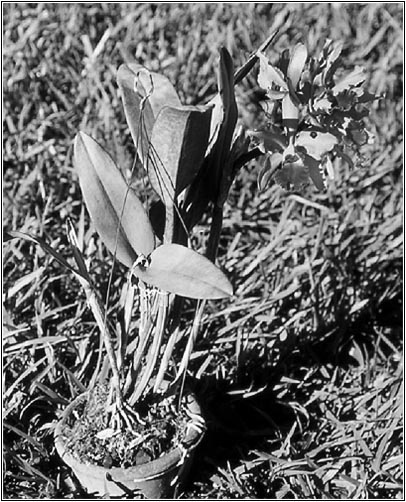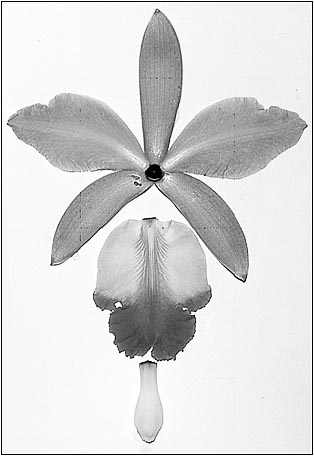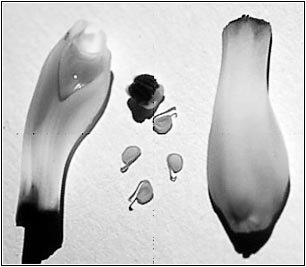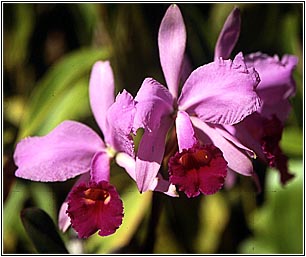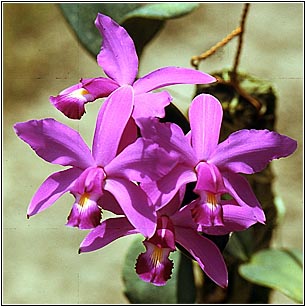|
A
new natural hybrid of Cattleya (Orchidaceae) from Roraima
(Brazil)
Richardiana VII(4)
- 185/191 - October 2007
Key-words:
Brazil, Cattleya, C. ×hummeliana, C. violacea,
C. lawrenceana, natural hybrid, Orchidaceae, Roraima.
Abstract
A new natural hybrid in Cattleya (Orchidaceae), from
Roraima (Brazil) between Cattleya violacea (HBR) Rolfe and
C. lawrenceana Reichenbach f., from Brazil (Roraima), is
described and illustrated, with comments about natural hybrids of
Brazilian orchids.
Introduction
The quite frequent occurrence of natural hybrids, already been mentioned
(Castro & Catharino 2004) and pointed out, in certain cases,
is a matter of ephemeral events while, in another, there is a fixation
of characters such is Cattleya dukeana Reichenbach f., found
in the coast of the state of São Paulo or Cattleya silvana
Pabst which is similar to Hadrolaelia grandis (Lindley &
Paxton) Chiron & V.P. Castro and to Cattleya warneri Moore.
In all those cases, the pollinator is not specific and, if the species
are sympatric and the blooming periods overlap, the occurrence of
a hybrid is really possible.
The
plant described was found in the state of Roraima,
Brazil, in a region next to the boundary with
Venezuela. The morphology of the plant show
the hybrid character of this plant which is confirmed
by the floral structure, the progenitors being
in evidence: Cattleya
violacea and C. lawrenceana which are
found together in the region where the natural
hybrid occurs.
Diagnose
Planta epiphytica et hybrida naturalis inter Cattleya
lawrenceana Rchb.f. et Cattleya violacea (Kunth)
Rolfe; pseudobulbis fusiformibus,pluriarticulatis
(3-5), apice 1-2 foliatis; foliis crassis, coriaceis;
inflorescentia terminali, erecta cum 3-5 floribus,
speciosis et odoratis; pseudobulbis et flores magnitude
et forma media inter species supra dictas; pollinia
4, cápsula perfecta ignota.
Habitat in Statu Roraima. Floruit in mense Octobri,
anni 2005 et 2006. Legit Lou Menezes. Holotypus
UB 97.
Etymology
The name pays homage to Dr. Antonio Carlos Hummel, Director Forest
Departments of IBAMA.
|
|
|
General
aspect of the plant
(Observe
that the pseudobulbs has one or two leaves)
|
|
|
|
|
Floral
Segments
|
Column
and pollinia
|
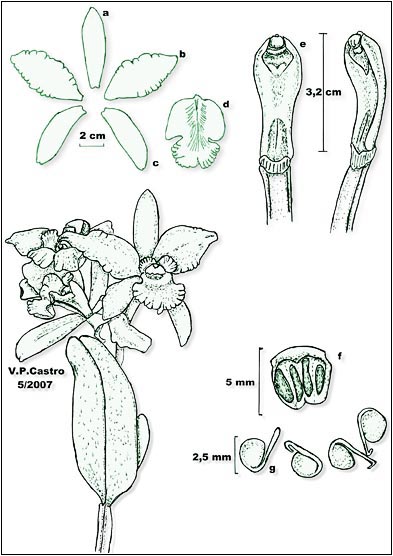 |
a : dorsal sepal
b : petals
c : lateral sepals
d : lip
e : column
f : anther
g : pollinia |
Cattleya x hummeliana L.C. Menezes & V.P.
Castro
Type draw, Vitorino P. Castro Neto, May 2007
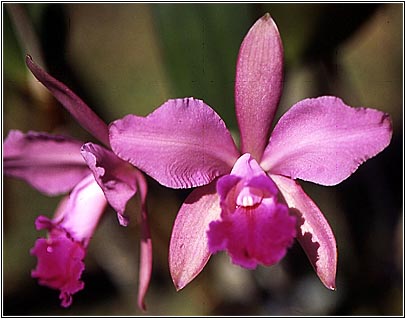 Cattleya x hummeliana
Cattleya x hummeliana
|
|
|
|
Cattleya lawrenceana
|
Cattleya violacea
|
Description
Epiphyte plant, almost without rhizome.
Pseudobulb cylindrical, from 13 to 26 cm high, with 5 internodes
and 1 or 2 apical leaves. Elliptic elongated leaves, 8-10 cm high
and 4-5 cm wide, distichous Short inflorescence at about
5-7 cm, emerging from a dried sheath. Flowers with 9cm diameter,
pink-reddish tepals, the petals are whitish along the central nervure,
the medium lobe is dark red, the lateral lobes have reddish edge,
the interior is white and the extremity has the same color as the
medium lobe, white column. Dorsal oblong-lanceolate sepal,
having 6,5 cm long and 1,8 cm wide.
Lateral sepals falciform, 6,0 cm long and 1,9 cm wide.
Elliptical petals 7 cm long and 3 cm wide.
Trilobate lip, the lateral lobes involving the column;
the medium lobe is reniform, 1,8 cm long and 3,7 cm wide, crisped
edges, short isthmus , 0,5 cm long and 2,3 cm wide; square lateral
lobes, round at the base and inflated in the apex, 3,0 cm long,
in the total, the lip is 6,0 cm long and 4,5 cm wide, opened. Triangular
column, curved in the apex, ventral face concave, with 2,5 cm long
and 0,8 cm wide. Semi-square white
anther, 5 mm long. 4 yellow pollinia. The stigmatic cavity is triangular
and concave.
Habitat
Roraima. In the boundary of Brazil and Venezuela. Blooming period:January-February.
Discussion
In the studied specimen, the two leaves remind those from C.
violacea, the medium lobe is more or less flatted showing the
ascendance of C. violacea, but the edges of the lateral lobes,
with the tip directed to the top, totally involving the column,
as well as the wide petals, typical of the unifoliate Cattleya
show the ascendance of Cattleya lawrenceana.
Bibliography
Braem, G. J., 1986. The unifoliate Cattleyas. Kurt Schmersow, Hildescheim.
Pabst, G. F. J. & F. Dungs, 1975. Orchidaceae Braziliensis.
Vol. 1, Brucke-Verlag Kurt Schmersow, Hildesheim.
Van der Pijl, L. & C. Dodson, 1966. Orchid flowers : their pollination
and evolution. Coral Gables, Univ. of Miami Press.
Photos:
L.C. Menezes
(*)
Lou Menezes, engineer of forestry/environmental analyst,
Orchids National Center (Centro Nacional de Orquídeas), Brazilian
Orchids Project, Orquidário Nacional do IBAMA, Brésil
- louorquidibama@hotmail.com.br
(**)
Rua Vicente Galafassi, 549 – 09770-480
S.B.Campo, SP, Brésil – vpcastro@superig.com.br
|

